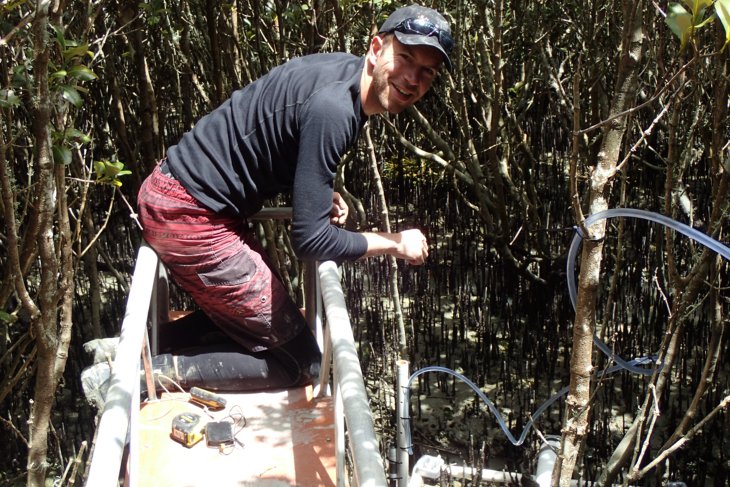“Mangroves are more than just trees,” says Horstman. “They form a powerful ecosystem that protects the coast from rising sea levels and severe storms.” Mangroves perform so well in this harsh environment because of their unique root system. “Mangroves have roots that stick out above the ground because the muddy soil they grow in lacks oxygen,” Horstman explains. Mangroves are also the only trees that can survive in salt water.
Slowing down currents and waves
But how exactly do mangroves work? Mangroves function as a natural defence against the force of the water. “The roots of mangroves act as a kind of filter,” Horstman explains. “When water flows through the roots, it slows down. This helps reduce the current's speed, allowing mud and sand to settle and preventing erosion (the wearing away of the coast). In this way, mangroves strengthen the coastline.” Mangroves also play a crucial role in reducing the impact of waves. “When waves hit the mangrove roots, they lose much of their strength,” says Horstman. This reduced force means that the impact of storm surges on the coast is greatly lessened. “It’s like the trees form a flexible wall that moves with nature,” he adds.
Protection from floods
One example of how effective mangroves are in protecting the coast can be seen in the Firth of Thames, New Zealand. “In the 1950s, it was mostly sandy beaches,” Horstman explains, “but now nature has taken its course, and there’s a mangrove area almost a kilometre wide.” These mangroves now act as a natural barrier, protecting the inland from flooding and keeping the coastline safe, even with rising sea levels.
On the Indonesian island of Arborek, mangroves are also actively used to protect the coast from erosion (the wearing away of the coast by water) and waves. “Mangroves can restore themselves after a storm and grow along with the rising sea levels,” says Horstman. This makes mangroves an excellent, sustainable solution for defending our coasts, unlike dikes, which constantly need to be reinforced.

Mongroves at Arborek, Indonesia (Picture of Erik Horstman)
Climate change
In addition to their role in coastal protection, mangroves also help fight climate change. “Mangroves can store up to ten times more carbon than normal forests,” Horstman explains. Mangroves absorb carbon dioxide, one of the main gases contributing to global warming. By storing carbon in their roots and leaves, and eventually in the soil, mangroves help to slow down climate change. This makes them a crucial ally in the fight against global warming.
Threats and restoration
Despite their superpowers, mangroves are under threat worldwide. “Since 1980, about 35% of mangroves have been lost,” says Horstman. This is mainly due to mangroves being cleared for shrimp farming, agriculture, and urban development. Although mangroves are so important for coastal protection and the climate, they are often overlooked.
Fortunately, there are initiatives to restore mangroves, such as in Indonesia, where 600,000 hectares of mangroves are being restored. “Restoration projects are not easy,” Horstman admits, “but if we carry them out well, mangroves can help us protect our coasts from storms and rising sea levels.”
The future of mangroves
Erik Horstman has a clear message: “We need to rethink our coastal protection strategies and pay more attention to preserving mangrove ecosystems.” By protecting and restoring mangroves, we can keep our coastlines safe and contribute to a sustainable future.
So, next time you think of the sea, don’t forget the mangroves – the trees that not only help protect the land from the sea but also contribute to the fight against climate change. These natural superheroes deserve our attention and protection!



